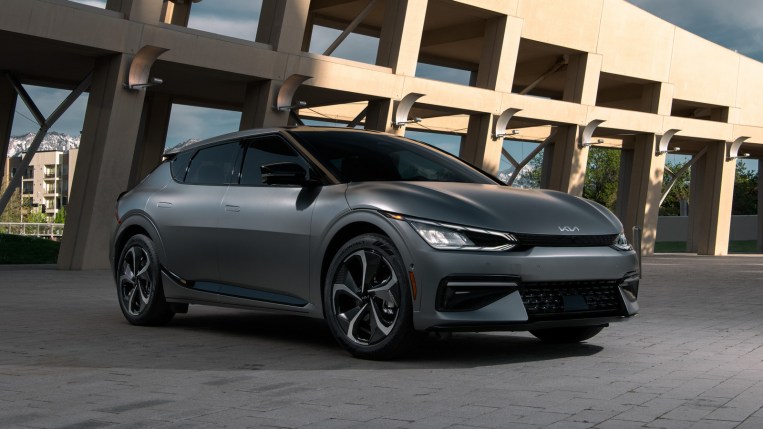Electric Cars 101: What You Need to Know About EVs

If you are thinking about driving greener with an electric car, you probably wonder what your options are and need answers to questions before you step away from your gas-powered vehicle.
Electric vehicles make up about 2% of the new cars on the road. Still, even 1% of the 15 million new cars and trucks sold each year is a lot of vehicles. And that figure will increase as manufacturers continue to introduce new models into the mainstream.
Below, we break down the different EV car options. We show you the basics of what you need to know about charging, range, ownership costs, safety features, and more so you can choose the right electric vehicle that meets all your needs.
Electric Vehicle Types: EV, BEV, HEV, PHEV, FCEV
An introduction to electric cars begins with an explanation of the abbreviations used to describe different types of electric vehicles.
EV
EV is the general catch-all term for an electric vehicle. Fully electric cars get all of their power from motors that use batteries charged with electricity. Another type, the fuel cell electric vehicle, or FCEV, runs on compressed hydrogen. There’s limited availability of hydrogen fuel cell cars, and they’re mostly available in California due to limited infrastructure available to the public outside of that state.
BEV
A BEV, or battery-powered electric vehicle, uses only its electric motor or motors for propulsion. Because they lack a traditional internal combustion engine and use no gasoline, BEVs produce no tailpipe emissions. This type of car is sometimes called an AEV, or all-electric vehicle.
HEV
HEV stands for hybrid electric vehicle. An HEV is an electric car that runs on both an internal combustion engine and an electric motor that uses energy from a battery. Hybrids use regenerative braking to store energy created when slowing the car to charge its battery. HEVs are known for their fuel economy because their reliance on battery power decreases how much gas the internal combustion engine uses.
PHEV
A PHEV is a plug-in hybrid. PHEVs plug into a power outlet to charge their batteries and use a petroleum-based or alternative fuel to power the internal combustion engine. Some PHEVs can travel 40 miles or more on electric power alone, rather than a couple of miles with a standard HEV.
FCEV
Fuel cell electric vehicles run on compressed hydrogen but are not widely available except in California. Filling up an FCEV is similar to fueling up a gas-powered vehicle. Due to the lack of availability of hydrogen fuel stations open to the public, it will take time for FCEVs to expand availability to other states.
Electric Vehicle Range
Electric car range can contribute to apprehension that buyers might feel while deciding to abandon their vehicle that uses a traditional gasoline engine. Even while today’s EVs can easily accommodate most daily driving, electric car battery manufacturers continue to improve capacity and recharge times.
- Many BEVs can travel more than 200 miles on a full battery charge, and the most advanced models can reach about 400 miles between charges. Both long-range and short-range EVs can perform well in start-and-stop driving during rush hour.
- BEVs consume significantly more of their battery at steady speeds on highways when used for more extended getaways.
- Hot weather and cold temperatures reduce the range of electric cars because of air conditioner and heater use.
RELATED CONTENT: 10 Longest-Range Electric Cars of 2021
EV Charging Stations
Some EV drivers worry persistently about depleting the battery without a charging station nearby. One perk of an electric vehicle is that you can plug in and recharge at home or use EV charging stations when you’re out and about.
A searchable map of electric vehicle charging stations from the United States Department of Energy Alternative Fuels Data Center shows at least 42,000 locations across the country. That number continues to grow.
There are Three Types of Chargers for Electric Cars
Level 1
This level refers to household three-prong outlets like those your computer or a desk lamp will use. Few electric car users charge their vehicles this way simply because of how long it takes. A Chevy Bolt EV, for instance, adds about four miles of range per hour this way. If you only need to add 20 or 30 miles of charge while at work, this can suffice.
Level 2
Most people prefer level 2 charging capability, whether at home or at a public charging station. These chargers provide 240 volts of power and require an external device that plugs into a receptacle like an electric clothes dryer. For example, Level 2 can add 25 miles of charge per hour to a Chevy Bolt EV, according to the car manufacturer.
Level 3
Also called a DC Fast Charger, the fastest-charging option is a Level 3 charger. These quick chargers can add 100 miles of range to a Chevy Bolt EV in 30 minutes. But you will only find Level 3 options in public charging stations that typically cost money to use.
Charging times are rough guidelines and estimates because electric cars also don’t charge at a constant rate. When looking at figures for the 5 Fastest-Charging Electric Cars, remember that manufacturers can claim whatever they’d like. No one is verifying what they say.
RELATED CONTENT: An EV Charger Buying Guide: See All Your Options
Electric Vehicle Recharging Cost
A common question from potential electric car buyers is how much does it cost to charge an EV? For charging at home, the answer requires some math and depends on several factors, primarily how much you drive and the price you pay for residential electricity.
Consider this rough example. If you put 1,000 miles on your vehicle each month and pay 10 cents for each kilowatt-hour of electricity, your at-home EV recharging bill will be $25 to $33 per month (based on the calculation of 3-4 driving miles equaling one kilowatt-hour). Even if you double your electric rate to 20 cents per kilowatt-hour, your EV recharging cost will be $50 to $66 each month.
Now, look at the cost of filling a tank with gasoline. Let’s say you’re driving an economical car that has a combined average of 30 miles per gallon during a mix of city and highway driving. Using a 12-gallon tank as a reference point, you’ll have 360 miles of driving range for each fill-up.
If you’re driving the same 1,000 miles per month, you’ll need to refuel at least three times each month. With the average price of gas hovering around $3 per gallon as of this writing, according to AAA, your monthly fuel expense will be about $108.
RELATED CONTENT: How Long Does It Take to Charge an Electric Car
EV Ownership Costs
A desire to do something to help save the planet, along with the potential for saving money on fuel and vehicle maintenance, typically rank as the top reasons for car buyers to explore the market of most popular electric cars.
Even so, the sticker price is typically higher for EVs than for comparable models equipped with gasoline engines. Buyers of some new BEVs and PHEVs might receive a tax break from their purchase. These incentives can drive down the overall price of a new electric car, but the benefits aren’t immediate, and the rules can be difficult to navigate. We break down the facts in our article about how electric car tax credits work.
EVs have greater depreciation than their gas-powered counterparts. While this can be disappointing to a buyer who drives off the lot in a new EV, it’s good news if you’re buying a used electric car.
- Use the battery life as a bargaining chip. Just like a mobile phone or laptop, an electric car’s battery begins to degrade over time. If you’re buying a used electric car for your commute, a shorter range may be just fine, but it’s a bargaining point if the battery is not new.
- Find out if the battery got replaced. Battery failure may be rare, but it does happen. Higher-mile electric cars are more likely to have had their batteries replaced entirely. If this has happened — and the seller can provide documentation confirming the work — it means that someone before you went through the effort and expense of having this job performed.
- Investigate how much battery warranty is left. All mainstream automakers include more extended warranty coverage for battery packs. Many used electric cars will still be under warranty. But read the fine print to learn whether it is transferable. Most battery coverage runs for eight years or 100,000 miles after the initial purchase, whichever comes first. However, not all warranties are transferable to subsequent owners.
Also, be sure to use Kelley Blue Book’s Car Recall tool to know what recall items may affect your used electric vehicle purchase.
Choosing All-Electric or Hybrid
There are many benefits to owning an EV, whether it’s a fully electric model or a plug-in hybrid. For starters, all EVs have lower overall fuel costs.
BEVs often have lower maintenance costs because they have fewer components than gas-powered cars. Battery-powered electric cars don’t require oil changes or tune-ups, typically only tire rotation and wiper replacement. Fully electric cars never need to stop at a gas station for fuel because their batteries can be charged at home when not in use.
PHEVs strike a balance between eco-friendly motoring and go-anywhere flexibility. Most commuters can drive to and from work on electric power alone, while the gas engine stands in reserve waiting for longer road trips.
When charged, a PHEV’s battery pack powers an electric motor. Once that battery pack depletes, a gas engine kicks on seamlessly. Then the car alternates between gasoline and electric power depending on how much is needed. The car’s regenerative braking system captures otherwise lost energy when coasting or slowing down and feeds it to the battery, further reducing its reliance on its gas engine.
RELATED CONTENT: Hyundai Kona Electric vs. Hybrid vs. Gas Ownership Cost Comparisons
EV Safety Features
Driving an electric car is no more dangerous than operating a traditional gas-powered vehicle. EVs are relatively new in the mainstream, but cutting-edge safety and driver-assist features are standard or available options for most models.
Price isn’t necessarily an indication of what level of advanced safety technology an electric vehicle packs. Every one of the following innovative safety features comes standard in a 2021 Nissan Leaf, which costs $31,670 plus destination charges of $950.
- Adaptive cruise control paces the speed of the car as the flow of traffic ahead slows and speeds up as the traffic does. See more information about adaptive cruise control.
- Blind-spot monitoring with rear cross-traffic alert senses vehicles in adjacent lanes and warns of objects behind your vehicle or crossing behind while backing up.
- Forward-collision warning with emergency braking detects a possible crash as your vehicle closes the distance with a vehicle or other object ahead. It can automatically apply the brakes if you don’t respond to a warning sound. Find out how Forward Collision Warning works.
- Lane-departure warning alerts when it senses the vehicle is drifting out of its lane.
- Lane-keeping assist nudges the vehicle back into its lane when a driver fails to respond to the lane-departure warning.
- Lane-centering assist serves to keep the vehicle in the center of its lane as a companion technology to lane-departure warning and lane-keeping assist.
- Rear automatic emergency braking senses objects behind your vehicle and automatically hits the brakes to avoid bumping them.
- 360-degree surround camera system provides a series of lenses placed around the vehicle for an all-around view to help with parking.
- Automatic high-beam technology detects lights ahead of the vehicle and deactivates the high beams when the system senses the distance closing between one car and another.
RELATED CONTENT: Our Favorite EV Safety Features and Brands That Offer Them








